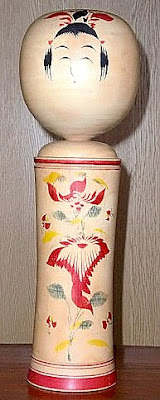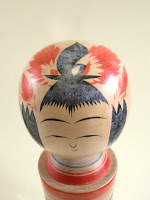The Icon in Traditional kokeshi - Naruko Kokeshi
Background of Naruko Kokeshi
Naruko is a onsen town located in Miyagi,Tohoku.It has been one of the three biggest onsen town in Tohoku - that means it has been the biggest of all kokeshi production towns.So,Naruko kokeshi is the most well-known to such an extent that its name ring a bell even with Japanese who know little about kokeshi like my father - he used to rub his stiff neck with kokeshi to relieve them.
There is a famous saying among kokeshi manias - "Kokeshi collecting starts and ends with Naruko".It vividly represents its popularity.So,maybe I should revise the title - "The King of traditional kokeshi".
Its beginning of kokeshi production was in early 19th.According to a folklore,the origin was a wooden charm figure by a native Shinto priest - he went to "Ise Grand Shrine" ,virtual head shrine in Japan,about 700km(450mile) far from his home all the way,and met across a wooden charm there.After returning his home,he made the doll on the model of the charm for souvenir.
(actually,this folklore is so important in the study of origin of kokeshi.I will talk about it next time.)
Naruko kokeshi is really the king in the following respect:
- the largest number of artisans
- strong leadership that it have inspired other kokeshi production areas
- many fans from beginners to experts
What's the draw? I think one of the keys is a "draw" -elegant drawing and painting.Anyway,see its features.
Truly Elegant Kokeshi
[kokeshi description]
- artisan : Akira Goto
- type : Traditional Naruko
- tall : 25cm(10inch)
- max width : 7cm(2.8inch)
- max circumference : 22cm(8.7inch)
Please see this floral patterns around the body(especially,lower part).This is chrysanthemum, as same as Togatta kokeshi.
The difference between them is its shape - one is lozenge-like pattern(somewhat extending downward),the other is repeated bowed patterns,the former called "Hishi-Kiku",literally lozenge-chrysanthemum,the latter called "Kasane-Kiku",piled up-chrysanthemum.
("Kiku" means chrysanthemum in Japanese).And this lozenge-chrysanthemum is the "trademark" of Naruko kokeshi.
See another picture.
Colourful and luxurious pattern! (if you don't think so,that's my fault.Sorry for my poor picture...)Such picture patterns are seen in Japanese pottery and porcelain,contemporary trendy product - yes,Naruko's patterns were inspired by them,so they were "the fashion icon" in traditional kokeshi.
Next is about her hair style.She plaits her hair in one thick braid with red ribbon,called "Mizu-hiki".This hair style with Mizu-hiki originally comes from Kyoto doll,where has been the major cultural center in Japan.We can also find she is truly cultured and elegant.
The third feature,but the most popular characteristic is "squeaky head" - when you twist her head,her head squeaks.Of-course,it is due not to her worn-out,but to a special set-up of attaching head part to body part.(and again off-course,I'm sorry that I'm never liable for the result of your twisting her head as heavily as twisting your waist).
Other Features:
- square shoulder(I think this is also urbane design like shoulder pat)
- gentle curbed body line,and (somewhat) hourglass body
- head diameter nearly same as body diameter
Straight-A student in Kokeshi
As a whole,she is perfect,and I find well-calculated design in her.I really respect the founders of Naruko kokeshi in terms of their pursuit of its formal beauty.But at the same time,and frankly speaking,I can't exactly understand - most kokeshi authorities say,"Simpleness and rusticity of kokeshi give us much tranquillity".And they also admire Naruko kokeshi as the representative of such kokeshi.I agree to the former in general,but how about the latter? I think she stands far from such unsophistication.
Maybe this is the matter of comparison not within kokeshi,but with other dolls and so on.And I might be jealous of her - because I had been C student at best,and even gotten "F" in art class...



